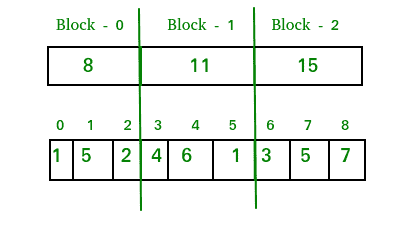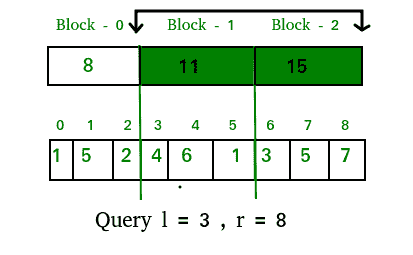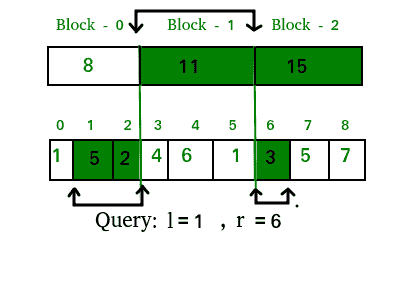# 平方根分解技术 系列 1(简介)
> 原文: [https://www.geeksforgeeks.org/sqrt-square-root-decomposition-technique-set-1-introduction/](https://www.geeksforgeeks.org/sqrt-square-root-decomposition-technique-set-1-introduction/)
平方根(Sqrt)分解技术是竞争程序员使用的最常见的[通用查询优化技术之一](https://www.geeksforgeeks.org/range-minimum-query-for-static-array/)。 此技术帮助我们将时间复杂度降低`sqrt(n)`。
*该技术的关键概念是将给定的数组分解为大小为`sqrt(n)`的小块。*
假设我们有一个`n`个元素的数组,然后将其分解为大小为`sqrt(n)`的小块。 如果`n`是一个完美的正方形,我们将恰好具有`sqrt(n)`这样的块。 因此,现在我们将`n`个元素上的数组分解为`sqrt(n)`块,其中每个块都包含`sqrt(n)`元素(假设数组的大小是完美正方形)。
让我们将这些块或块视为一个单独的数组,每个数组包含`sqrt(n)`元素,并且您已经针对所有块分别计算了所需的答案(根据您的问题)。 现在,您需要回答某些查询,询问原始`n`大小数组中范围为`l`到`r`(`l`和`r`是数组的开始和结束索引)的元素的答案。
**朴素的方法**只是简单地遍历范围`l`到`r`中的每个元素,并计算其相应的答案。 因此,每个查询的时间复杂度将为`O(n)`。
**平方分解技巧**:由于我们已经预先计算了所有单个数据块的答案,现在我们需要回答范围`l`到`r`的查询。 现在,我们可以简单地组合原始数组中介于`l`到`r`之间的块的答案。 因此,如果我们在这里仔细观察,我们将一次跳过`sqrt(n)`步,而不是像朴素的方法那样一次跳过 1 步。 让我们考虑以下问题来分析其时间复杂度和实现:
```
Problem :
Given an array of n elements. We need to answer q
queries telling the sum of elements in range l to
r in the array. Also the array is not static i.e
the values are changed via some point update query.
Range Sum Queries are of form : Q l r ,
where l is the starting index r is the ending
index
Point update Query is of form : U idx val,
where idx is the index to update val is the
updated value
```
让我们考虑一下,我们有 9 个元素组成的数组。
`A [] = {1, 5, 2, 4, 6, 1, 3, 5, 7}`
让我们将此数组分解为`sqrt(9)`块,其中每个块将包含其中的元素总和。 因此,现在我们的分解数组将如下所示:

到目前为止,我们已经构造了分解后的`sqrt(9)`块数组,现在我们需要打印给定范围内的元素总数。 因此,首先让我们看一下范围查询可以在数组上出现的两种基本重叠类型:
**类型 1 的范围查询(给定范围位于块边界上)**:

在这种类型的查询中,范围可能完全覆盖连续的`sqrt`块。 因此,我们可以轻松地将此范围内的值之和回答为完全重叠的块之和。
因此,上述图像中上述查询的答案将是:`ans = 11 + 15 = 26`
**时间复杂度**:在最坏的情况下,我们的范围可以是 0 至`n-1`(其中`n`是数组的大小,并假设`n`是一个完美的正方形)。 在这种情况下,我们的查询范围将所有块完全重叠。 因此,要回答此查询,我们需要遍历该数组的所有分解块,并且知道块数`= sqrt(n)`。 因此,在最坏的情况下,此类查询的复杂度将为`O(sqrt(n))`。
**类型 2 的范围查询(鉴于范围不在边界上)**

我们可以通过对位于查询范围内的完全重叠的分解块中的数据求和,然后对来自原始数组的元素进行逐一求和,而原始数组的原始块的相应块未与查询范围完全重叠,则可以处理此类查询。
因此,上述图像中上述查询的答案将是:`ans = 5 + 2 + 11 + 3 = 21`
**时间复杂度**:让我们考虑一个查询`[l = 1, r = n-2]`(`n`是数组的大小,并具有从 0 开始的索引)。 因此,对于该查询,正好`sqrt(n) – 2`块将完全重叠,其中第一个和最后一个块将部分重叠,而重叠范围之外仅剩一个元素。 因此,完全重叠的块可以在`(sqrt(n) – 2) ~ sqrt(n)`迭代中求和,而第一个块和最后一个块需要分别遍历。 但是我们知道每个块中的元素数量为最大`sqrt(n)`,所以要单独求和最后一个块,我们需要进行`(sqrt(n) - 1) ~ sqrt(n)`个迭代。
因此,总体复杂度`= O(sqrt(n))+ O(sqrt(n))+ O(sqrt(n))= O(3 * sqrt(N))= **O(sqrt( n))`
**更新查询(点更新)**:
在此查询中,我们仅查找给定索引所在的块,然后减去其先前的值并根据点更新查询添加新的更新值。
**时间复杂度**:`O(1)`
**实现**:
下面给出了上述技巧的实现
## C++
```cpp
// C++ program to demonstrate working of Square Root
// Decomposition.
#include "iostream"
#include "math.h"
using namespace std;
#define MAXN 10000
#define SQRSIZE 100
int arr[MAXN]; // original array
int block[SQRSIZE]; // decomposed array
int blk_sz; // block size
// Time Complexity : O(1)
void update(int idx, int val)
{
int blockNumber = idx / blk_sz;
block[blockNumber] += val - arr[idx];
arr[idx] = val;
}
// Time Complexity : O(sqrt(n))
int query(int l, int r)
{
int sum = 0;
while (l<r and l%blk_sz!=0 and l!=0)
{
// traversing first block in range
sum += arr[l];
l++;
}
while (l+blk_sz <= r)
{
// traversing completely overlapped blocks in range
sum += block[l/blk_sz];
l += blk_sz;
}
while (l<=r)
{
// traversing last block in range
sum += arr[l];
l++;
}
return sum;
}
// Fills values in input[]
void preprocess(int input[], int n)
{
// initiating block pointer
int blk_idx = -1;
// calculating size of block
blk_sz = sqrt(n);
// building the decomposed array
for (int i=0; i<n; i++)
{
arr[i] = input[i];
if (i%blk_sz == 0)
{
// entering next block
// incementing block pointer
blk_idx++;
}
block[blk_idx] += arr[i];
}
}
// Driver code
int main()
{
// We have used separate array for input because
// the purpose of this code is to explain SQRT
// decomposition in competitive programming where
// we have multiple inputs.
int input[] = {1, 5, 2, 4, 6, 1, 3, 5, 7, 10};
int n = sizeof(input)/sizeof(input[0]);
preprocess(input, n);
cout << "query(3,8) : " << query(3, 8) << endl;
cout << "query(1,6) : " << query(1, 6) << endl;
update(8, 0);
cout << "query(8,8) : " << query(8, 8) << endl;
return 0;
}
```
- GeeksForGeeks 数组教程
- 介绍
- 数组介绍
- C/C++ 中的数组
- Java 中的数组
- Python 中的数组| 系列 1(简介和功能)
- C# | 数组
- 回转
- 数组旋转程序
- 数组旋转的逆向算法
- 数组旋转的块交换算法
- 程序循环旋转一个数组
- 在经过排序和旋转的数组中搜索元素
- 给定一个经过排序和旋转的数组,查找是否存在一对具有给定总和的数组
- 在只允许旋转给定数组的情况下找到Sum(i * arr[i])的最大值
- 给定数组所有旋转中i * arr [i]的最大和
- 在旋转排序数组中找到旋转计数
- 快速找到数组的多个左旋转| 系列 1
- 在经过排序和旋转的数组中找到最小元素
- 数组右旋转的逆向算法
- 查找具有最大汉明距离的旋转
- 数组左右循环查询
- 在O(n)时间和O(1)空间中打印数组的左旋转
- 旋转几次后,在给定索引处查找元素
- 拆分数组并将第一部分添加到末尾
- 重排
- 重新排列数组,使arr[i] = i
- 编写程序以反转数组或字符串
- 重新排列数组,如果i为偶数则arr[i] >= arr[j],如果i为奇数且j < i则 arr[i] <= arr[j]
- 在O(n)时间和O(1)额外空间中重新排列正数和负数
- 重新排列数组,交替出现&个正数的负数项,多余的空间为O(1) | 系列 1
- 将所有零移动到数组末尾
- 将所有零移动到数组的末尾| 系列 2(使用单遍历)
- 将所有小于或等于 k 的元素组合在一起所需的最小交换
- 使用内置排序功能重新排列正数和负数
- 重新排列数组,使偶数位置大于奇数
- 按顺序重新排列数组-最小,最大,第二个最小,第二个最大..
- 将第一个元素加倍,然后将零移动到结尾
- 根据给定的索引对数组重新排序
- 用恒定的额外空间重新排列正数和负数
- 排列给定数字以形成最大数| 系列 1
- 重新排列数组,如果arr[i]为j,则arr[j]变为i | 系列 1
- 以最大最小形式重新排列数组| 系列 1
- 以最大最小形式重新排列数组| 系列 2(O(1)额外空间)
- 将所有负元素移动到最后,并留出足够的空间
- 重新排列数组,使偶数索引元素较小而奇数索引元素较大
- 正数元素位于偶数位置,负数元素位于奇数位置(不保持相对顺序)
- 用上一个和下一个的乘法替换每个数组元素
- 使用 Fisher-Yates 随机播放算法随机播放给定数组
- 分离偶数和奇数| 系列 3
- 将数组中的 0 和 1 分开
- 最长的双子序列| DP-15
- 在线性时间内找到大小为 3 的排序子序列
- 最大数目等于 0 和 1 的子数组
- 最大产品子数组
- 用右侧的最大元素替换每个元素
- 最大循环子数组总和
- 最长递增子序列的构造(N log N)
- 按频率对元素排序| 系列 2
- 最大化圆形数组中的连续差之和
- 根据另一个数组定义的顺序对数组进行排序
- 查找索引 0 替换为 1,以获得二进制数组中最长的连续序列 1s
- 在给定范围内对数组进行三向分区
- 从两个给定排序数组的备用元素生成所有可能的排序数组
- 安排彼此相邻的线对所需的最小交换次数
- 将数组转换为 Zig-Zag 风格
- 从给定序列中形成最小数
- 将两个连续的相等值替换为一个更大的值
- 重新排列二进制字符串作为 x 和 y 的交替出现
- 数组中不同的相邻元素
- 不使用多余空间将 2n 个整数随机排列为 a1-b1-a2-b2-a3-b3-.bn
- 合并 k 个排序的数组| 系列 1
- 订单统计
- 未排序数组中第 K 个最小/最大元素| 系列 1
- 未排序数组中第 K 个最小/最大元素| 系列 2(预期线性时间)
- 未排序数组中第 K 个最小/最大元素| 组合 3(最坏情况的线性时间)
- 使用 STL 的第 K 个最小/最大元素
- 数组中的 k 个最大(或最小)元素| 添加了最小堆方法
- 按行和按列排序的 2D 数组中的 Kth 个最小元素| 系列 1
- 程序以查找数组中的最大元素
- 查找数组中最大的三个元素
- 查找数组中至少有两个大元素的所有元素
- 未排序数组的均值和中位数的程序
- 使用 STL 的运行整数流的中位数
- 正整数数组中 k 个整数的最小积
- 第 K 个最大和的连续子数组
- 来自两个数组的 K 个最大和组合
- 重叠的连续子数组的 K 个最大和
- 非重叠的连续子数组的 K 个最大和
- 使用O(1)额外空间按相同顺序排列 k 个最小元素
- 在两个数组中找到具有最小和的 k 对
- 数组中两个元素的第 k 个最小绝对差
- 在数组中查找第二大元素
- 查找给定数组中出现次数最多的 k 个数字
- 查找数组中的最小和第二个最小元素
- 寻找最小的遗失号码
- 使得两个元素都不相邻的最大和
- 使用最少数量的比较的数组的最大值和最小值
- 两个元素之间的最大差异,使得较大的元素出现在较小的数字之后
- 给定数组 arr [],找到最大 j – i,使得 arr [j] > arr [i]
- 最大滑动窗口(大小为 k 的所有子数组的最大值)
- 找到两个数字之间的最小距离
- 在先增加然后减少的数组中找到最大元素
- 计算右侧较小的元素
- 最长递增子序列大小(N log N)
- 查找未排序数组中缺失的最小正数| 系列 1
- 在O(n)时间和O(1)多余空间中找到最大重复数
- 给定大小为 n 且数字为 k 的数组,找到出现次数超过 n / k 次的所有元素
- 找出长度为 3 且具有最大乘积的递增子序列
- 两个数组中的最大求和路径
- 从两个排序的数组中找到最接近的对
- 在未排序的数组中找到最大的对和
- 整个数组中最小的较大元素
- 删除小于 next 或变得更小的数组元素
- 在线检查回文的在线算法
- 删除小于 next 或变得更小的数组元素
- 找到要翻转的零,以使连续的 1 的数目最大化
- 计算严格增加的子数组
- 流中的第 K 个最大元素
- 在两个数组中找到具有最小和的 k 对
- k 元素组与数组其余部分之间的最大差值。
- 要使中位数等于 x 的最小元素数量
- 下一个更大的元素
- 范围查询
- MO 的算法(查询平方根分解)| 系列 1(简介)
- Sqrt(或平方根)分解技术 系列 1(简介)
- 稀疏表
- 使用稀疏表进行范围总和查询
- 范围最小查询(平方根分解和稀疏表)
- 数组元素的频率范围查询
- 数组上的恒定时间范围添加操作
- 范围 LCM 查询
- 数组中给定索引范围的 GCD
- 查询给定数组中所有数字的 GCD(给定范围内的元素除外)
- 给定子数组中小于或等于给定数目的元素数
- 给定子数组中小于或等于给定数字的元素数| 第 2 组(包括更新)
- 查询值在给定范围内的数组元素的计数
- 查询二进制数组的子数组的十进制值
- 计算将 L-R 范围内的所有数字相除的元素
- 给定数组范围的 XOR 之和最大的数字
- 在给定范围内出现偶数次的数字的 XOR
- 范围查询中的数组范围查询
- 数组范围查询以搜索元素
- 数组范围查询频率与值相同的元素
- 给定范围内的最大出现次数
- 给定范围内具有相等元素的索引数
- 合并排序树以获取范围顺序统计信息
- 范围内没有重复数字的总数
- 差异数组|O(1)中的范围更新查询
- 对数组的范围查询,其每个元素都是索引值与前一个元素的 XOR
- 查找子数组是否为山脉形式
- 范围总和查询,无更新
- 子数组中的素数(带有更新)
- 在二进制数组中检查子数组表示的数字是奇数还是偶数
- 用于乘法,替换和乘积的数组查询
- 数组范围的平均值
- 执行加减命令后打印修改后的数组
- 在给定范围内对偶数或奇数概率的查询
- 数组中范围的乘积
- 计算范围内的素数
- M 个范围切换操作后的二进制数组
- 合并重叠间隔
- 检查给定间隔中是否有两个间隔重叠
- 间隔之和与除数的更新
- 多次数组范围递增操作后打印修改后的数组
- 范围最大奇数的 XOR 查询
- 查询子数组中不同元素的数量
- 计数和切换二进制数组上的查询
- 数组中的最小-最大范围查询
- 优化问题
- 最大总和连续子数组
- 通过最多买卖两次股份获得最大利润
- 查找平均数最少的子数组
- 找到两个数字之间的最小距离
- 最小化高度之间的最大差异
- 到达终点的最小跳数
- 最大总和增加子序列| DP-14
- 总和大于给定值的最小子数组
- 查找 k 个长度的最大平均子数组
- 计算最小步数以获得给定的所需数组
- 乘积小于 k 的子集数
- 查找使数组回文的最小合并操作数
- 查找不能表示为给定数组的任何子集之和的最小正整数值
- 具有最大总和的子数组的大小
- 找出任何两个元素之间的最小差异
- 使用位操作进行空间优化
- 两个二进制数组中具有相同总和的最长跨度
- 排序
- 替代排序
- 对几乎排序(或 K 排序)的数组进行排序
- 根据给定值的绝对差对数组进行排序
- 以波形形式对数组进行排序
- 将大小为 n 的数组合并为大小为 m + n 的另一个数组
- 对包含 1 到 n 个值的数组进行排序
- 通过交换相邻元素将 1 排序为 N
- 对包含两种类型元素的数组进行排序
- 按频率对元素排序| 系列 1
- 计算数组中的反转 系列 1(使用合并排序)
- 两个元素的和最接近零
- 最短无序子数组
- 排序数组所需的最小交换次数
- 两个排序数组的并集和交集
- 查找两个未排序数组的并集和交集
- 对 0、1 和 2 的数组进行排序
- 找到最小长度未排序子数组,进行排序,使整个数组排序
- 中位数为整数流(运行整数)
- 计算可能的三角形数量
- 查找数组中的对数(x,y),使得 x ^ y > y ^ x
- 计算所有等于 k 的不同对
- 打印给定整数数组的所有不同元素
- 从其对和数组构造一个数组
- 合并两个有O(1)额外空间的排序数组
- 第一个数组中的最大值与第二个数组中的最小值的乘积
- 对数(a [j] > = a [i])的对数,其中 k 个范围在(a [i],a [j])中,可被 x 整除
- 随机对为最大加权对的概率
- AP 数组中存在的最小解排列(算术级数)
- 对两个数组的最小乘积之和进行重新排列
- 将数组划分为 k 个片段,以最大化片段最小值的最大值
- 最小乘积对为正整数数组
- 计算形成最小产品三胞胎的方法
- 检查是否反转子数组使数组排序
- 使用另一个数组最大化元素
- 使两个数组的元素相同,最小增减
- 检查是否有任何间隔完全重叠
- 除子数组中的元素外,对数组进行排序
- 对除一个以外的所有数组元素进行排序
- 排序二进制数组所需的最小相邻交换
- 按数组中出现的元素顺序对链接列表进行排序
- 打印数组中排序的不同元素
- 可以单独排序以进行排序的最大分区数
- 使用 STL 根据因素数量进行排序
- 每次取下最小的钢丝绳后剩下的钢丝绳
- 数组中所有元素的排名
- 合并 3 个排序的数组
- 使数组递减的最小减法运算数
- 最大化 arr [i] * i 的总和
- 差异小于 K 的对
- 按排序顺序合并两个未排序的数组
- 从两个数组最大化唯一对
- 应用给定方程后对数组排序
- 每个数组元素的最小绝对差之和
- 查找是否可以使用一个外部数字使数组元素相同
- 两个未排序数组之间的最小差值对
- 程序检查数组是否排序(迭代和递归)
- 查找大于数组中一半元素的元素
- 使两个数组相同的最小交换
- 要添加的元素,以便数组中存在某个范围的所有元素
- 正在搜寻
- 搜索,插入和删除未排序的数组
- 在排序的数组中搜索,插入和删除
- 给定数组 A []和数字 x,请检查 A []中的对,总和为 x
- 在相邻项最多相差 k 的数组中搜索
- 在三个排序的数组中查找共同的元素
- 在无数排序数组中查找元素的位置
- 查找 1 到 n-1 之间的唯一重复元素
- 查找在数组中一次出现的元素,其中每个其他元素出现两次
- 排除某些元素的最大子数组总和
- 数组中的最大平衡和
- 数组的平衡指数
- 领导者数组
- 天花板排列
- 多数元素
- 检查排序数组中的多数元素
- 检查数组是否具有多数元素
- 两指针技术
- 查找峰元素
- 找到给定数组中的两个重复元素
- 在给定的数组中找到一个固定点(等于索引的值)
- 查找给定总和的子数组| 系列 1(负数)
- 数组中的最大三元组和
- 来自三个数组的最小差异三元组
- 查找一个三元组,将其总和成给定值
- 找到所有零和的三元组
- 所有合计给定值的唯一三元组
- 计算总数小于给定值的三元组
- 打印形成 AP 的排序数组中的所有三元组
- XOR 为零的唯一三元组数
- 找到一个三元组,使得两个和等于第三元素
- 查找出现次数的奇数
- 查找丢失的号码
- 计算排序数组中的出现次数(或频率)
- 给定一个已排序的数组和一个数字 x,在数组中找到总和最接近 x 的对
- 在排序的二进制数组中计数 1
- 在整数数组中找到第一个重复元素
- 从重复的数组中查找丢失的元素
- 找到重复的和丢失的| 添加了 3 种新方法
- 在未排序的数组中找到出现奇数的两个数字
- 找到具有给定差异的一对
- 找到四个总和为给定值的元素| 集合 1(n ^ 3 解)
- 找到四个总和为给定值的元素| 系列 2
- 查找是否有一个总和为 0 的子数组
- 在相邻元素之间的差为 1 的数组中搜索元素
- 一系列不同元素中的第三大元素
- 检查数组中是否存在两个元素的总和等于数组其余部分的总和
- 检查给定数组是否包含彼此之间 k 距离内的重复元素
- 使用最少的比较次数搜索未排序数组中的元素
- 连续元素排序数组中仅重复元素的计数
- 在频率大于或等于 n / 2 的排序数组中查找元素。
- 圆形数组中相邻元素的最小绝对差
- 在数组中找到第一个,第二个和第三个最小元素
- 程序来查找数组的最小(或最大)元素
- 每个数组元素中另一个数组中最接近的较大元素
- 计算O(1)额外空间和O(n)时间中数组中所有元素的频率
- 与给定的总和和距末端的最大最短距离配对
- 从数组中删除一个元素(使用两次遍历和一次遍历)
- 计算给定数组中大小为 3 的反转
- 计算给定总和的对
- 对排序向量中的二分搜索
- 困雨水
- 替换元素会使数组元素连续
- 排序数组中的第 k 个缺失元素
- O(log(min(n(n,m)))中具有不同大小的两个排序数组的中位数
- 从两个排序的数组中打印不常见的元素
- 非重复元素
- 数组中最频繁的元素
- 数组中最少的元素
- m 个元素的两个子集之间的最大差
- n 个数组中升序元素的最大和
- 配对使得一个是其他的幂倍
- 查找数组中对的数量,以使它们的 XOR 为 0
- 两次最大出现之间的最小距离
- 如果我们在数组中每次成功搜索后加倍,则找到最终值
- 排序数组中的最后一个重复元素
- 找到一个数组元素,使所有元素都可被它整除
- 以原始顺序查找数组的 k 个最大元素
- 数组中的最大值,至少是其他元素的两倍
- 连续步骤到屋顶
- 两个大小的组之间的最大差异
- 两个大小的组之间的最小差异
- 未排序整数列表中最接近的数字
- 值和索引和的最大绝对差
- 数组中局部极值的数量
- 检查数组是否具有多数元素
- 查找数组中最接近的数字
- 最大和的对数
- 按原始顺序打印给定数组中的 n 个最小元素
- 查找给定数组中缺少的前 k 个自然数
- 数组中的高尚整数(大于等于的元素数等于 value)
- 两个数组对的绝对差的最小和
- 查找数组中非重复(不同)元素的总和
- 检查是否可以从给定数组形成算术级数
- 数组的最小乘积子集
- 计算选择差异最大的对的方法
- 每次成功搜索后通过将元素加倍来重复搜索
- 允许负数的数组中成对乘积的最大和
- 矩阵
- 旋转矩阵元素
- 将方形矩阵旋转 90 度| 系列 1
- 将矩阵旋转 90 度,而无需使用任何额外空间| 系列 2
- 将矩阵旋转 180 度
- 用 K 元素逆时针旋转矩阵的每个环
- 将图像旋转 90 度
- 检查矩阵的所有行是否都是彼此旋转
- 排序给定矩阵
- 查找最大数量为 1 的行
- 在按行排序的矩阵中找到中位数
- 矩阵乘法| 递归的
- 程序将两个矩阵相乘
- 矩阵的标量乘法程序
- 程序打印数组的下三角和上三角矩阵
- 查找矩阵所有行共有的不同元素
- 以螺旋形式打印给定的矩阵
- 查找矩阵中每一行的最大元素
- 在矩阵中查找唯一元素
- 将矩阵元素逐行移动 k
- 矩阵的不同运算
- 以逆时针螺旋形式打印给定矩阵
- 交换方矩阵的主要和次要对角线
- 矩阵中的最大路径总和
- 矩阵对角元素的正方形
- 沿给定方向移动矩阵元素并添加具有相同值的元素
- 按升序对矩阵行进行排序,然后按降序对列进行排序
- 矩阵中间行和列的总和
- 矩阵的按行遍历与按列遍历
- 向右旋转矩阵 K 次
- 检查幂等矩阵的程序
- 程序检查对合矩阵
- 矩阵中第一行和最后一行的交换元素
- zag-zag 方式打印矩阵
- 二维数组中的按行排序
- 马尔可夫矩阵程序
- 检查对角矩阵和标量矩阵的程序
- 按行和列对矩阵进行排序
- 查找岛屿数| 系列 1(使用 DFS)
- 魔术广场| 偶数订单
- 魔术广场
- 检查给定矩阵是否为幻方
- 检查给定矩阵是否为幻方
- 两种矩阵的 Kronecker 积
- 计数总和可分为“ k”的子矩阵
- 对角占优矩阵
- 使矩阵的每一行和每一列相等所需的最少操作
- 计算大小为 n 的矩阵中 k 的频率,其中 matrix(i,j)= i + j
- 给定 1、2、3……k 以之字形打印它们。
- 皇后可以在棋盘上移动的障碍物数量
- 矩阵中 4 个相邻元素的最大积
- 使二进制矩阵对称所需的最小翻转
- 程序检查矩阵是否为下三角
- 程序检查矩阵是否为上三角
- 矩阵中偶数和奇数的频率
- 矩阵的中心元素等于对角线的一半
- 身份矩阵程序
- 程序用矩阵的下对角元素交换上对角元素。
- 稀疏矩阵表示| 系列 3(CSR)
- 填充矩阵以使所有行和所有列的乘积等于 1 的方式
- 矩阵对角线的镜像
- 查找二进制矩阵中是否有一个角为 1 的矩形
- 查找所有填充有 0 的矩形
- 矩阵或网格中两个单元之间的最短距离
- 计算二进制矩阵中 1 和 0 的集合
- 搜索按行和按列排序的矩阵
- 创建具有 O 和 X 的交替矩形的矩阵
- 矩阵的锯齿形(或对角线)遍历
- 原位(固定空间)M x N 大小的矩阵转置| 更新
- 排序从 0 到 n ^ 2 – 1 的数字矩阵的最低成本
- 二进制矩阵中的唯一像元
- 计算特殊矩阵中等于 x 的条目
- 检查给定矩阵是否稀疏
- 方矩阵的两个对角线中的行式公共元素
- 检查矩阵中第 i 行和第 i 列的总和是否相同
- 查找最大数为 1 的二进制矩阵的行号
- 程序检查矩阵是否对称
- 通过遵循单元格值来查找二维数组是否被完全遍历
- 程序以 Z 格式打印矩阵
- 在矩阵中从左上到右下打印所有回文路径
- 骑士的可能举动
- 有效地计算矩阵的对角线总和
- 矩阵的边界元素
- 从点开始以螺旋形式打印矩阵
- 以蛇形图案打印矩阵
- 矩阵对角线互换程序
- 找出两个对角线之和之间的差
- 从给定的二叉树构造祖先矩阵
- 从祖先矩阵构造树
- 圆形矩阵(以螺旋方式构造数字 1 到 m * n 的矩阵)
- Sudoku Generator 程序
- 康威人生游戏计划
- 矩阵中沙漏的最大和
- 方阵中的最大值和最小值。
- 以防螺旋形式打印矩阵
- 查找矩阵的法线和迹线的程序
- 以各种方式对矩阵进行排序
- 设置二进制矩阵的所有元素所需的最少操作
- 以反向螺旋形式打印给定的矩阵
- C 程序检查矩阵是否倾斜对称
- 矩阵元素的总和,其中每个元素是行和列的整数除法
- 稀疏矩阵及其表示| 系列 2(使用列表和键字典)
- 查找使两个矩阵相等的变换数
- 形成矩阵线圈
- 每个元素是其行号和列号的绝对差的矩阵总和
- 检查二进制矩阵中的水平和垂直对称性
- 每个值为 0 或 n 的矩阵的最大行列式
- 螺旋奇数阶方阵的两个对角线之和
- 在二进制矩阵中找到具有最大位差的行对
- 查找矩阵中给定行的所有置换行
- 在二进制矩阵中查找以 1s 形成的形状的周长
- 在矩阵中打印具有相同矩形和的单元格
- 以对角线图案打印矩阵
- 矩阵中两行元素之和的最大差
- 查找具有给定总和的对,以便该对的元素位于不同的行中
- 二进制矩阵中所有零的总覆盖率
- 用行或列的最大 GCD 替换每个矩阵元素
- 计算矩阵中所有排序的行
- 矩阵查询
- 矩阵中的最大 XOR 值
- 可以从下到右传输光线的最大反射镜
- 最后一个方块的方向
- 以矩阵的螺旋形式打印第 K 个元素
- 查找给定的矩阵是否为 Toeplitz
- 在按行和按列排序的矩阵中计数零
- 在列明智和行明智排序矩阵中计算负数
- 在二进制矩阵中查找所有位形成的最大“ +”的大小
- 返回扩展矩阵中的前一个元素
- 使用O(1)额外空间打印 n x n 螺旋矩阵
- 二进制迷宫中的最短路径
- 查找矩阵中图案的方向
- 在矩阵中查找特定对
- 打印给定大小的最大和平方子矩阵
- 给定矩阵的所有行中的公共元素
- 按特定顺序就地转换矩阵
- 布尔矩阵问题
- 给定布尔矩阵,找到 k,使第 k 行中的所有元素均为 0,第 k 列为 1。
- 在给定的布尔矩阵中打印唯一行
- 找到 1 的最大矩形,并允许交换列
- 给定井字棋盘配置的有效性
- 子矩阵总和查询
- 矩阵排名程序
- 全为 1 的最大尺寸矩形二进制子矩阵
- 全为 1 的最大尺寸正方形子矩阵
- 查找矩阵中除给定单元格的行和/或列中的元素以外的所有元素的总和?
- 计算每个岛按行和列分隔的岛数
- 在给定的按行排序的矩阵的所有行中找到一个公共元素
- 给定矩阵“ O”和“ X”,如果被“ X”包围,则将“ O”替换为“ X”
- 给定矩阵“ O”和“ X”,找到被“ X”包围的最大子正方形
- 洪水填充算法–如何在 paint 中实现 fill()?
- 从行和列的排序矩阵中按排序顺序打印所有元素
- 给定一个 n x n 方阵,求出大小为 k x k 的所有子方和
- 查找矩阵转置的程序
- 用于添加两个矩阵的程序
- 矩阵减法程序
- 使用两次遍历收集网格中的最大点
- 在死胡同之前收集最多硬币
- 正好有 k 个硬币的路径数
- 查找从给定起始字符开始的最长连续路径的长度
- 在给定约束条件下找到矩阵中的最长路径
- 到达目的地的最低初始点
- 分而治之| 第 5 组(Strassen 的矩阵乘法)
- 2D 矩阵中的最大和矩形| DP-27
- 杂项
- 子数组/子字符串与子序列以及生成它们的程序
- 产品数组难题
- 具有给定乘积的子数组数
- 链表与数组
- 检查数组元素是否连续 新增方法 3
- 查找一个数组是否是另一个数组的子集 新增方法 3
- 在一个数组中实现两个堆栈
- 查找两个排序数组的相对补码
- 通过 k 次运算的最小增量以使所有元素相等
- 最小化三个不同排序数组的(max(A [i],B [j],C [k])– min(A [i],B [j],C [k]))
